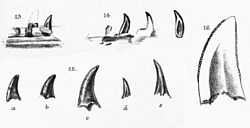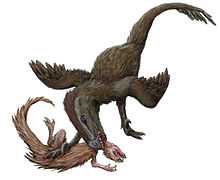Nuthetes
| Nuthetes Temporal range: Early Cretaceous, 143Ma | |
|---|---|
 | |
| Portions of the holotype mandible and close up of a tooth | |
| Scientific classification | |
| Kingdom: | Animalia |
| Phylum: | Chordata |
| Clade: | Dinosauria |
| Suborder: | Theropoda |
| Family: | †Dromaeosauridae |
| Clade: | †Eudromaeosauria |
| Subfamily: | †Velociraptorinae |
| Genus: | †Nuthetes Owen, 1854 |
| Species: | † N. destructor |
| Binomial name | |
| Nuthetes destructor Owen, 1854 | |
| Synonyms | |
|
Megalosaurus destructor (Owen, 1854) | |
Nuthetes is the name given to a dubious, possibly dromaeosaurid, genus of theropod dinosaur, known only from fossil teeth and jaw fragments found in rocks of the middle Berriasian (Early Cretaceous) age in the Cherty Freshwater Member of the Lulworth Formation in England. As a dromaeosaurid Nuthetes would have been a small predator, about two metres long.
Naming
The genus Nuthetes contains one species (the type species), Nuthetes destructor. N. destructor was named and described by Richard Owen in 1854.[1] The generic name Nuthetes is derived from the Koine Greek nouthetes, a contraction of νουθέτητης (nouthetetes) meaning "one who admonishes" or "a monitor," in reference to the similarity of Nuthetes teeth to those of a modern monitor lizard.[2] The specific name is Latin for "destroyer", a reference to "the adaptations of the teeth for piercing, cutting, and lacerating the prey" of a form he estimated to be equal in size to the present Bengal monitor.[3]
History
The holotype, DORCM G 913, was collected by Charles Willcox, an amateur paleontologist living at Swanage, from the Feather Quarry near Durlston Bay in a marine deposition of Cherty Freshwater Member of the Lulworth Formation, dating from the middle Berriasian. It consists of an about three inch long left dentary fragment with nine teeth. The holotype was once thought to be lost but was rediscovered in the seventies in the Dorset County Museum. Later several other teeth and specimen BMNH 48207, another dentary fragment from a somewhat smaller individual, were referred to the species. Owen in 1878 also assumed some fossilised scutes, of a type for which he coined the name "granicones",[4] belonged to Nuthetes but these were in 2002 shown to be limb or tail osteoderms of a turtle, possibly Helochelydra anglica or "Tretosternon" bukewelli.[5]
In 2006 a tooth from France found in Charente, specimen CHEm03.537, was referred to a Nuthetes sp.[6]
Classification

Nuthetes was originally classified by Owen as a lizard and a varanid; later he changed his mind concluding it was a crocodilian.[7] Only in 1888 Richard Lydekker understood it was a dinosaur. In 1934 William Elgin Swinton thought it was a juvenile member of the Megalosauridae. In 1970 Rodney Steel even renamed the species Megalosaurus destructor. In 2002 however, a re-examination of the fossils by paleontologist Angela Milner showed that they most likely belonged to a subadult dromaeosaurid.[8] Steve Sweetman examined five good specimens of fossil teeth and confirmed that they belong to Nuthetes destructor, and concluded that this species is a velociraptorine dromaeosaurid. If this placement is correct, it would have been one of the oldest dromaeosaurids known, the first to be described, and the first known from Britain.[9] However, Rauhut, Milner and Moore-Fay (2010) pointed out the great similarity of the teeth of basal tyrannosauroid Proceratosaurus to the teeth of velociraptorine dromaeosaurids. The authors recommended caution when referring isolated teeth from the Late Jurassic or Early Cretaceous to the Dromaeosauridae (explicitly citing Milner's 2002 study and Sweetman's 2004 study as examples of studies that identified isolated theropod teeth as belonging to dromaeosaurids), as these teeth might belong to proceratosaurid tyrannosauroids instead.[10]
Some large specimens referred to Nuthetes may instead belong to Dromaeosauroides.[11]
References
- ↑ Owen, R., 1854, "On some fossil reptilian and mammalian remains from the Purbecks", Quarterly Journal of the Geological Society of London, 10: 420-43
- ↑ Glut, D.F. (2002). Dinosaurs: The Encyclopedia Supplement 2. McFarland & Company, 686 pp. ISBN 978-0-7864-1166-5
- ↑ Owen, R., 1861, "Monograph on the fossil Reptilia of the Wealden and Purbeck formations. Part V. Lacertilia (Nuthetes, etc.)", The Palaeontological Society, London 1858: 31-39
- ↑ Owen, R., 1878, "On the fossils called 'granicones'; being a contribution to the histology of the exo-skeleton in 'Reptilia'", Journal of the Microscopical Society, 1: 233-236
- ↑ Barrett, P. M., Clarke, J. B., Brinkman, D. B., Chapman, S. D., and Ensom, P. C., 2002, "Morphology, histology and identification of 'granicones' from the Purbeck Limestone Formation (Lower Cretaceous: Berriasian) of Dorset, southern England", Cretaceous Research, 23: 279-295
- ↑ Pouech, Joane; Mazin, Jean-Michel and Billon-Bruyat, Jean-Paul, 2006, "Microvertebrate biodiversity from Cherves-de-Cognac (Lower Cretaceous, Berriasian: Charente, France)", In: 9th International Symposium, Mesozoic Terrestrial Ecosystems and Biota, Manchester 2006, Abstracts and Proceedings volume. p.96-100. View this article online
- ↑ Owen, R., 1879, "Monograph on the fossil Reptilia of the Wealden and Purbeck formations. Supplement no. IX. Crocodilia (Goniopholis, Brachydectes, Nannosuchus, Theriosuchus, and Nuthetes)", The Palaeontographical Society 1879, 1-19
- ↑ Milner, A. (2002). "Theropod dinosaurs of the Purbeck Limestone Group, southern England." In: Milner and Batten (eds.). Life and Environment in Purbeck Times. Special Paper in Palaeontology, 68(268): 191-201.
- ↑ Sweetman, S.C. (2004). "The first record of velociraptorine dinosaurs (Saurischia, Theropoda) from the Wealden (Early Cretaceous, Barremian) of southern England." Cretaceous Research, 25(3): 353-364. doi:10.1016/j.cretres.2004.01.004
- ↑ Rauhut, Oliver W. M.; Milner, Angela C.; Moore-Fay, Scott (2010). "Cranial osteology and phylogenetic position of the theropod dinosaur Proceratosaurus bradleyi (Woodward, 1910) from the Middle Jurassic of England". Zoological Journal of the Linnean Society 158 (1): 155–195. doi:10.1111/j.1096-3642.2009.00591.x.
- ↑ Bonde, N. (2012). "Danish Dinosaurs: A Review". In Godefroit, P. Bernissart Dinosaurs. Indiana University Press. pp. 435–449.
External links
- Extensive description from the Milner paper, on the Dinosaur Mailing List.
- Described as a dromaeosaurid